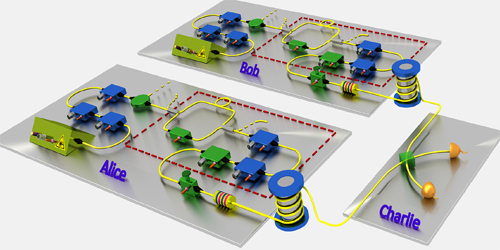Researchers Solve Mystery of Historic 1952 London Fog and Current Chinese Haze
November 14, 2016

A fog blanketed London in December 1952, killing as many as 12,000 people and puzzling researchers for decades. Texas A&M researchers believe they have solved the mystery.
Few Americans may be aware of it, but in 1952 a killer fog that contained pollutants covered London for five days, causing breathing problems and killing thousands of residents. The exact cause and nature of the fog has remained mostly unknown for decades, but an international team of scientists that includes several Texas A&M University-affiliated researchers believes that the mystery has been solved and that the same air chemistry also happens in China and other locales.
Texas A&M researcher Renyi Zhang, University Distinguished Professor and the Harold J. Haynes Chair of Atmospheric Sciences and Professor of Chemistry, along with graduate students Yun Lin, Wilmarie Marrero-Ortiz, Jeremiah Secrest, Yixin Li, Jiaxi Hu and Bowen Pan and researchers from China, Florida, California Israel and the UK have had their work published in the current issue of
Proceedings of the National Academy of Sciences (PNAS).
In December of 1952, the fog enveloped all of London and residents at first gave it little notice because it appeared to be no different from the familiar natural fogs that have swept over Great Britain for thousands of years.
But over the next few days, conditions deteriorated, and the sky literally became dark. Visibility was reduced to only three feet in many parts of the city, all transportation was shut down and tens of thousands of people had trouble breathing. By the time the fog had lifted on Dec. 9, at least 4,000 people had died and more than 150,000 had been hospitalized. Thousands of animals in the area were also killed.
Recent British studies now say that the death count was likely far higher – more than 12,000 people of all ages died from the killer fog. It has long been known that many of those deaths were likely caused by emissions from coal burning, but the exact chemical processes that led to the deadly mix of fog and pollution have not been fully understood over the past 60 years.
The 1952 killer fog led to the passage of the Clean Air Act in 1956 by the British Parliament and is still considered the worst air pollution event in the European history.
Through laboratory experiments and atmospheric measurements in China, the team has come up with the answers.
“People have known that sulfate was a big contributor to the fog, and sulfuric acid particles were formed from sulfur dioxide released by coal burning for residential use and power plants, and other means,” Zhang says.
“But how sulfur dioxide was turned into sulfuric acid was unclear. Our results showed that this process was facilitated by nitrogen dioxide, another co-product of coal burning, and occurred initially on natural fog. Another key aspect in the conversion of sulfur dioxide to sulfate is that it produces acidic particles, which subsequently inhibits this process. Natural fog contained larger particles of several tens of micrometers in size, and the acid formed was sufficiently diluted. Evaporation of those fog particles then left smaller acidic haze particles that covered the city.”
The study shows that similar chemistry occurs frequently in China, which has battled air pollution for decades. Of the 20 most polluted cities in the world, China is home to 16 of them, and Beijing often exceeds by many times the acceptable air standards set by the U.S. Environmental Protection Agency.
“The difference in China is that the haze starts from much smaller nanoparticles, and the sulfate formation process is only possible with ammonia to neutralize the particles,” Zhang adds.
“In China, sulfur dioxide is mainly emitted by power plants, nitrogen dioxide is from power plants and automobiles, and ammonia comes from fertilizer use and automobiles. Again, the right chemical processes have to interplay for the deadly haze to occur in China. Interestingly, while the London fog was highly acidic, contemporary Chinese haze is basically neutral.”
Zhang says China has been working diligently over the past decade to lessen its air pollution problems, but persistent poor air quality often requires people to wear breathing masks during much of the day. China’s explosive industrial and manufacturing growth and urbanization over the past 25 years have contributed to the problem.
“A better understanding of the air chemistry holds the key for development of effective regulatory actions in China,” he adds.
“The government has pledged to do all it can to reduce emissions going forward, but it will take time,” he notes. “We think we have helped solve the 1952 London fog mystery and also have given China some ideas of how to improve its air quality. Reduction in emissions for nitrogen oxides and ammonia is likely effective in disrupting this sulfate formation process.”
The study was funded by the National Natural Science Foundation of China, the Robert A. Welch Foundation, the Ministry of Science and Technology of China, a US National Science Foundation Fellowship, a NASA Earth and Space Science Fellowship, and a collaborative research grant between Texas A&M and China.
Researchers Solve Mystery of Historic 1952 London Fog and Current Chinese Haze | Texas A&M Today
Journal Reference:
- Gehui Wang, Renyi Zhang, Mario E. Gomez, Lingxiao Yang, Misti Levy Zamora, Min Hu, Yun Lin, Jianfei Peng, Song Guo, Jingjing Meng, Jianjun Li, Chunlei Cheng, Tafeng Hu, Yanqin Ren, Yuesi Wang, Jian Gao, Junji Cao, Zhisheng An, Weijian Zhou, Guohui Li, Jiayuan Wang, Pengfei Tian, Wilmarie Marrero-Ortiz, Jeremiah Secrest, Zhuofei Du, Jing Zheng, Dongjie Shang, Limin Zeng, Min Shao, Weigang Wang, Yao Huang, Yuan Wang, Yujiao Zhu, Yixin Li, Jiaxi Hu, Bowen Pan, Li Cai, Yuting Cheng, Yuemeng Ji, Fang Zhang, Daniel Rosenfeld, Peter S. Liss, Robert A. Duce, Charles E. Kolb, Mario J. Molina. Persistent sulfate formation from London Fog to Chinese haze. Proceedings of the National Academy of Sciences, 2016; 201616540 DOI: 10.1073/pnas.1616540113



















